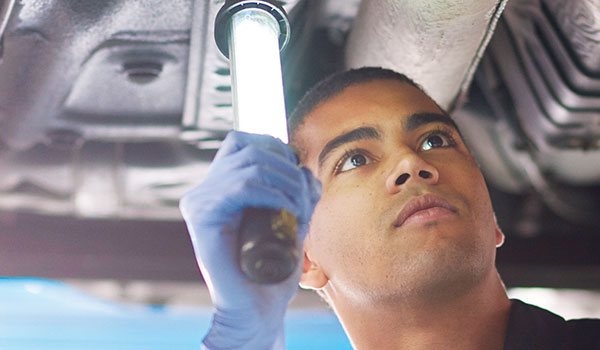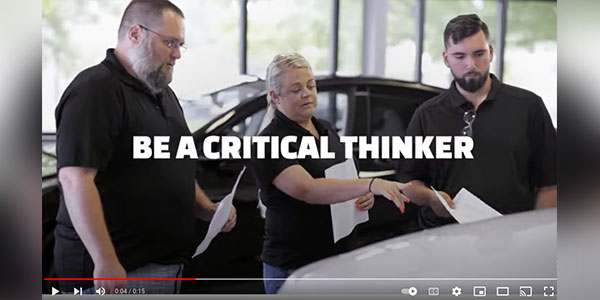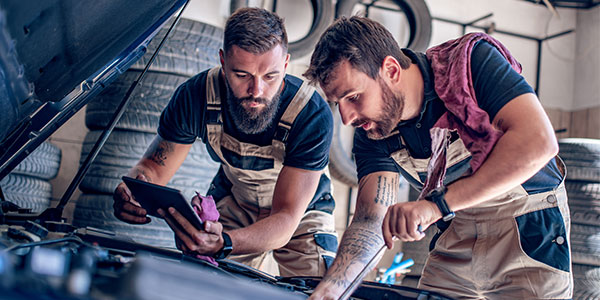This month, we’re going to review some of the current technology available for leak detection, and go over some useful leak detection procedures. We’ll cover “wet” leaks, which includes fluids that can be seen, or systems that have a liquid carrier for dye, making these a little easier to get a handle on. We’ll also cover “dry” leaks, such as evaporative emission, intake and exhaust leaks. With these systems, there is nothing to drip, and no liquid carrier for any type of dye, so diagnosis can be a little trickier. OK, let’s get into it.
“Wet” Leaks
In many cases, we can find the source of the leak just by looking, but it’s the small leaks and the occasional drop on a garage floor that can be difficult to track down. Fluorescent dye is available for all types of oil-based fluids and coolants, and it’s great to keep a supply of these around the shop. Using these dyes, along with a UV leak detection lamp and the stylish dye-enhancing goggles that accompany the kits, you’ll be able to quickly pinpoint the source of all leaks, even ones that your customer is not aware of.
Air conditioning systems can be a little more daunting, since the refrigerant will sneak out of the most microscopic of holes and disappear without a trace. There are two options to track down these elusive leaks. First, there are multiple electronic leak detectors on the market, commonly called “sniffers.” Basic models will give you an audible warning when they pick something up, with the more advanced also being equipped with visual indicators to represent how close you are to the source of the leak. Most new models should be compatible with all refrigerants, including the newer 1234-yf, but make sure you do your homework to determine which one has the options you need.
Option two is leak detection dye. Offered in many different ways from single applications, to larger cartridges for high-volume shops, this fluorescent dye will give you conclusive evidence every time. Utilized again with a UV leak detection lamp and dye-enhancing goggles, you’ll be able to pinpoint the leak with absolute certainty. Don’t take shortcuts when looking for an A/C leak. Many components are sandwiched in tight locations, or tucked up above fender liners. Remove everything you can to get a look at as much of the system as possible. In many cases there is more than one leak, and you want to make sure you find them all the first time.
“Dry” Leaks
With the ever-increasing complexity of today’s vehicles, we need modern tools on our side to fight the battle against these types of leaks. With no fluid to drip and leave easy signs to follow, for diagnosis, we rely on what is most commonly known as “the smoke machine.” Although the name may always stick, this is no ’70s disco, and this equipment, due to its ability to do more than just pump out smoke, rightly deserves to be called by the more accurate title of “Leak Detection Equipment.”
We’ll start with EVAP systems. When deciding what tools are best for you, an understanding of the available features for this type of equipment will put you ahead of the game. The smoke that is pumped into the system is just one of the key functions of a leak detector. Some are available that do only this and they work very well in many situations, but the more advanced units come with an incorporated pressure gauge, flow meter and control valve to isolate the system being tested, which will increase your diagnostic ability considerably. It is also best to consider the different adapters and connectors that come with different models. The more adapters you have available to you, the more uses you can get out of the equipment. Most will come with the standard EVAP service port adapter, but optional fuel filler neck connectors can be worth their weight in gold.
When it comes down to looking for the leak, there are a few simple things that can shorten up your EVAP diagnostic time. First, you’ll need a scanner to control the vent valve. The vent valve will need to be shut, or there will be visible smoke everywhere and you won’t be able to pinpoint any other leaks.
Second, the equipment can be connected to the EVAP service port, but these can be tricky to find, and even then you may have to fight with dirt and contaminants, or the possibility of the valve core sticking and causing you a headache down the road. This is where a fuel filler neck connector proves a worthwhile investment.
Third, equipment with a pressure gauge and flow meter are the keys to quick diagnosis. Monitor the flow meter as you pressurize the system with smoke, and it should drop to zero fairly quickly as long as there are no large leaks and the vent valve is shut. Once the flow meter is at zero, isolate the system by closing the control valve on the unit, and monitor the pressure gauge. It should hold, indicating a sealed system. If it drops, now is the time to look for signs of smoke to pinpoint the leak. If you can’t find an external leak, don’t forget to check the purge valve.
A final note for EVAP systems: don’t forget the fuel cap seal. This can only be checked by utilizing the EVAP service port, so if you’re using a filler neck connector and everything checks OK, you’ll have to switch over to the EVAP service port so you can complete your diagnosis with the fuel cap on.
Lighting is important for locating smoke, especially a small trickle of it. Many leak detectors come with a bright halogen light, which will reflect visibly off of the smoke vapors. Others come with a UV leak detection lamp and enhancing goggles to provide easy visibility of the fluorescent dye that is carried in some smoke solutions, which brings us to another feature for consideration when selecting leak detection equipment — the use of dye.
Dye is most widely used in systems that have a liquid to carry the dye throughout, such as an A/C system. In the case of a dry system, there are many leak detection units that are designed to work with a special smoke solution, which suspends the fluorescent dye and carries it along, releasing it and depositing it where the smoke escapes, such as a small hole or break in a hose. This is a great option, and most of us are all quite familiar with the pinpoint accuracy that using a dye can provide, but before deciding to go this route, make sure that its use is not prohibited by the vehicle manufacturer. Many automakers support it and recommend it, but some of them do not, so you’ll want to check first.
Moving on to intake systems, these leaks on today’s cars are simply unacceptable. Modern vehicle systems can and will detect even the smallest amount of unmetered air, and you’ll need proper leak detection equipment to find it. Generally speaking, if you have a leak detector with a number of different adapters, you can seal off the inlet from the air box and let the smoke do the rest. What can make this difficult is that many leaks are very small, and they may also leak, or not leak, depending on engine temperature. This is a very good example of where a leak detector with fluorescent dye can be a valuable asset.
The next hurdle comes from turbo and supercharged engines. They have reached the point where we’re seeing them every day, and these require yet another level of equipment for leak testing intake systems. Traditional leak testing equipment operates at very low pressure, and boost levels in these engines are continuously being pushed higher and higher, especially with the ease and popularity of aftermarket “tunes,” and low-pressure leak testers simply cannot provide results. The solution is a high-pressure automotive leak detector. This equipment not only provides you with inflatable bladders that will seal off the intake and exhaust systems, but it is designed to work at the high pressures found in today’s boosted engines, making it capable of finding leaks.
We’ll finish off the “dry” systems with exhaust, which plays a bigger part in a vehicle’s performance than we often think about. Of course we all know that exhaust leaks can cause a check engine light to come on, depending on their location, but there are additional performance issues that can arise as well. Exhaust systems are designed for the engine and the car that they come on, and any change or alteration, including leaks, can not only affect the sound, but horsepower, torque and fuel efficiency. Modern leak detection equipment will provide you with a quick and easy way to find even the smallest of these exhaust leaks, allowing you to keep your customer’s car safe and performing flawlessly like it is designed to do.
To finish up, we’ll touch briefly on the safety factor. Often asked is the question of whether to use nitrogen or compressed air as the pressure source for your leak detector. For EVAP systems, the answer is simple: nitrogen. It’s an inert (non-reactive) gas, and for safety reasons, it’s what you should use. Shop air, while it might be quicker and easier, contains oxygen, which when mixed with the fumes inside a fuel tank, creates an extremely flammable and explosive mixture. For intake and exhaust testing, compressed air is fine.
As a final note to the really cool equipment that you can get, there are also leak detectors that have their own on-board compressors for the ultimate in portability and ease of use.
Good leak detection equipment can save you a lot of time, making you more profitable and providing a better service for your customer. Like all of your best tools, this equipment is an investment in your future.














